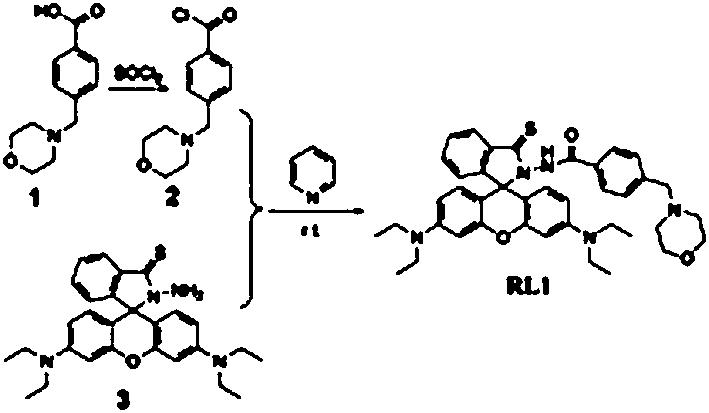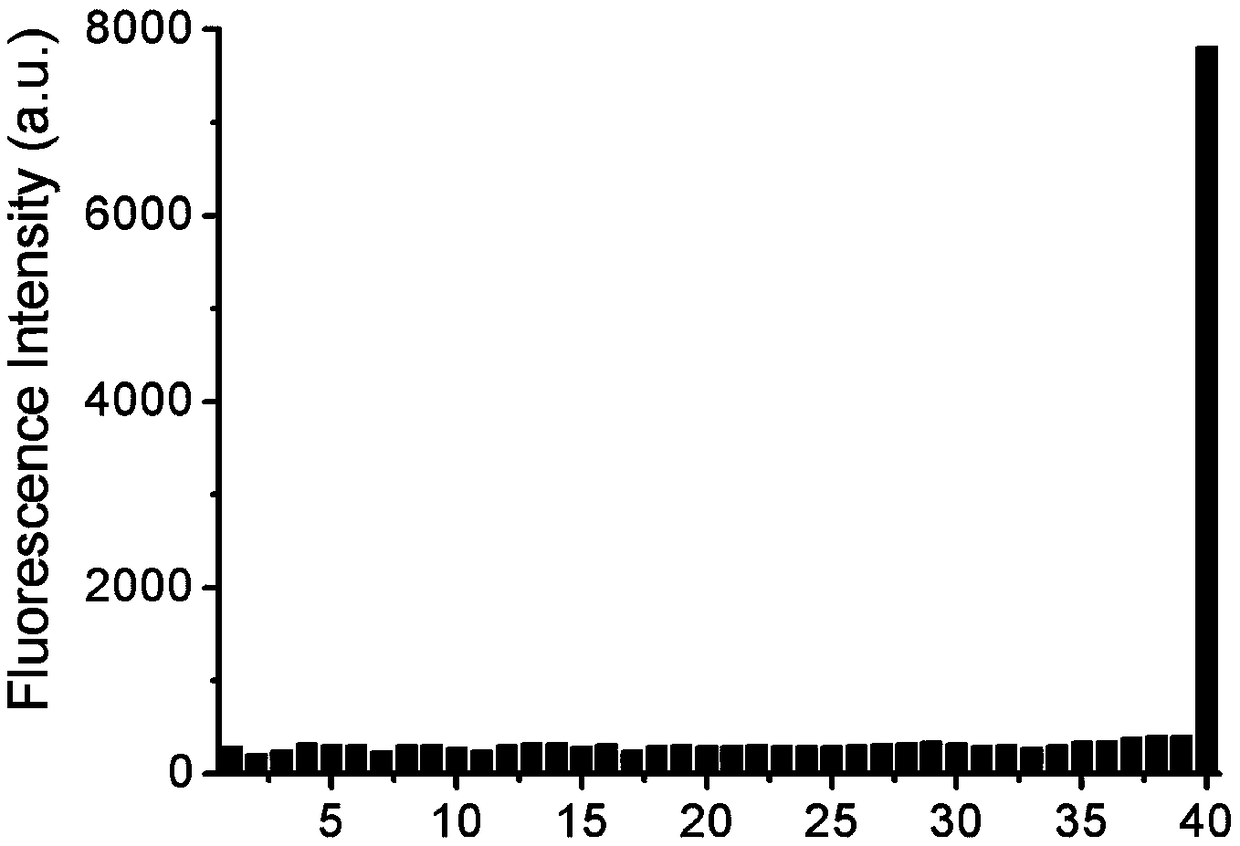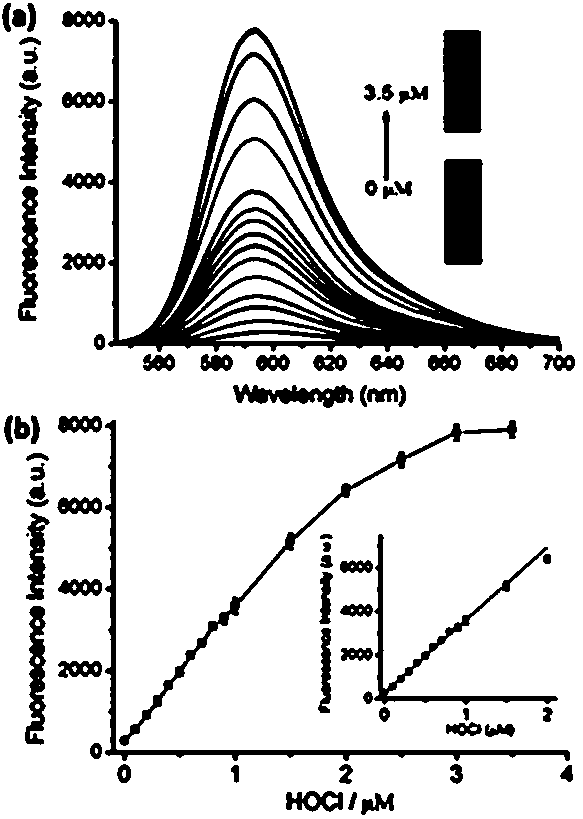Rhodamine B type fluorescent probe capable of being applied to detection of HOCl in cytolysosome
A technology of fluorescent probes and lysosomes, applied in the direction of fluorescence/phosphorescence, luminescent materials, measuring devices, etc., can solve the problems that hypochlorous acid fluorescent probes do not have organelle targeting function, are not applicable, and are difficult to study
- Summary
- Abstract
- Description
- Claims
- Application Information
AI Technical Summary
Problems solved by technology
Method used
Image
Examples
Embodiment 1
[0023] Embodiment 1: The synthetic route of probe sees figure 1 .
[0024] Compound 1 (2 mmol) was dissolved in 10 mL SOCl 2 After heating to reflux for 2 hours, the solvent was removed under reduced pressure to obtain solid 2 (not purified, directly used in the next reaction).
[0025] Compound 2 (2 mmol) was dissolved in 10 mL of dry pyridine, stirred at room temperature for about 1 hour, then compound 3 (1 mmol) was added to the reaction system, and stirred at room temperature for 12 hours. The reaction solution was poured into 150 mL of dichloromethane, then washed three times with 200 mL of water, the organic phase was dried with anhydrous sodium sulfate, the solvent was removed under reduced pressure, and then separated by column chromatography to obtain the probe RL1 of the present invention, White solid, 45% yield.
[0026] by 1 H NMR, 13 C NMR and HRMS carry out its structure, the data are as follows:
[0027] 1 H NMR (400 MHz, d 6 -DMSO), δ (ppm): 1.09 (t, 1...
Embodiment 2
[0031] Prepare 1 μM probe in PBS buffer solution (containing 1% ethanol, pH 5.00). Then add the following ions respectively, 1: blank, 2: Na + , 3: K + , 4: Ca 2+ , 5: Mg 2+ , 6: Zn 2+ , 7: Al 3+ , 8: Cu 2+ , 9: Mn 2+ , 10: Li + , 11:Co 2+ , 12: Hg 2+ , 13: Pb 2+ , 14: F - , 15: Cl - , 16: Br - , 17: I - , 18: AcO - , 19: NO 3 - ,20: NO 2 - , 21: S 2 o 3 2- , 22: HCO 3 - , 23: HPO 4 2- , 24: HS - , 25: SO 4 2- , 26: Asn, 27: Asp, 28: Glu, 29: Gly, 30: Hcy, 31: Ser, 32: Trp, 33: Cys, 34: H 2 o 2 , 35: t -BuOOH,36: t -BuO•, 37: 1 o 2 , 38: - o 2 , 39: •OH, 40: HOCl. Concentration: 40 µM for (2)-(39); 3 µM for (40). Find by fluorescence test, only when HOCl exists, probe just has fluorescent emission at 592 nm, and other ions can not cause probe to change fluorescence at 592 nm, so probe of the present invention is sensitive to hypochlorous acid have good selectivity, such as figure 2 shown.
Embodiment 3
[0033]Prepare 1 μM probe in PBS buffer solution (containing 1% ethanol, pH 5.00). Add 0 μM, 0.1 μM, 0.2 μM, 0.3 μM, 0.4 μM, 0.5 μM, 0.6 μM, 0.7 μM, 0.8 μM, 0.9 μM, 1.0 μM, 1.5 μM, 2.0 μM, 2.5 μM, 3.0 μM, 3.5 μM hypochlorous acid, and then carry out fluorescence spectrum analysis, the results show that the fluorescence emission of the probe at 592nm becomes stronger with the increase of hypochlorous acid concentration, as shown in image 3 As shown, figure (a) is the fluorescence emission diagram of the probe in different concentrations of HOCl, and figure (b) is the relationship between the fluorescence intensity of the probe at 592 nm and the concentration of HOCl. The experimental results show that the probe can be used for the detection of HOCl in solution.
PUM
 Login to View More
Login to View More Abstract
Description
Claims
Application Information
 Login to View More
Login to View More - R&D Engineer
- R&D Manager
- IP Professional
- Industry Leading Data Capabilities
- Powerful AI technology
- Patent DNA Extraction
Browse by: Latest US Patents, China's latest patents, Technical Efficacy Thesaurus, Application Domain, Technology Topic, Popular Technical Reports.
© 2024 PatSnap. All rights reserved.Legal|Privacy policy|Modern Slavery Act Transparency Statement|Sitemap|About US| Contact US: help@patsnap.com










